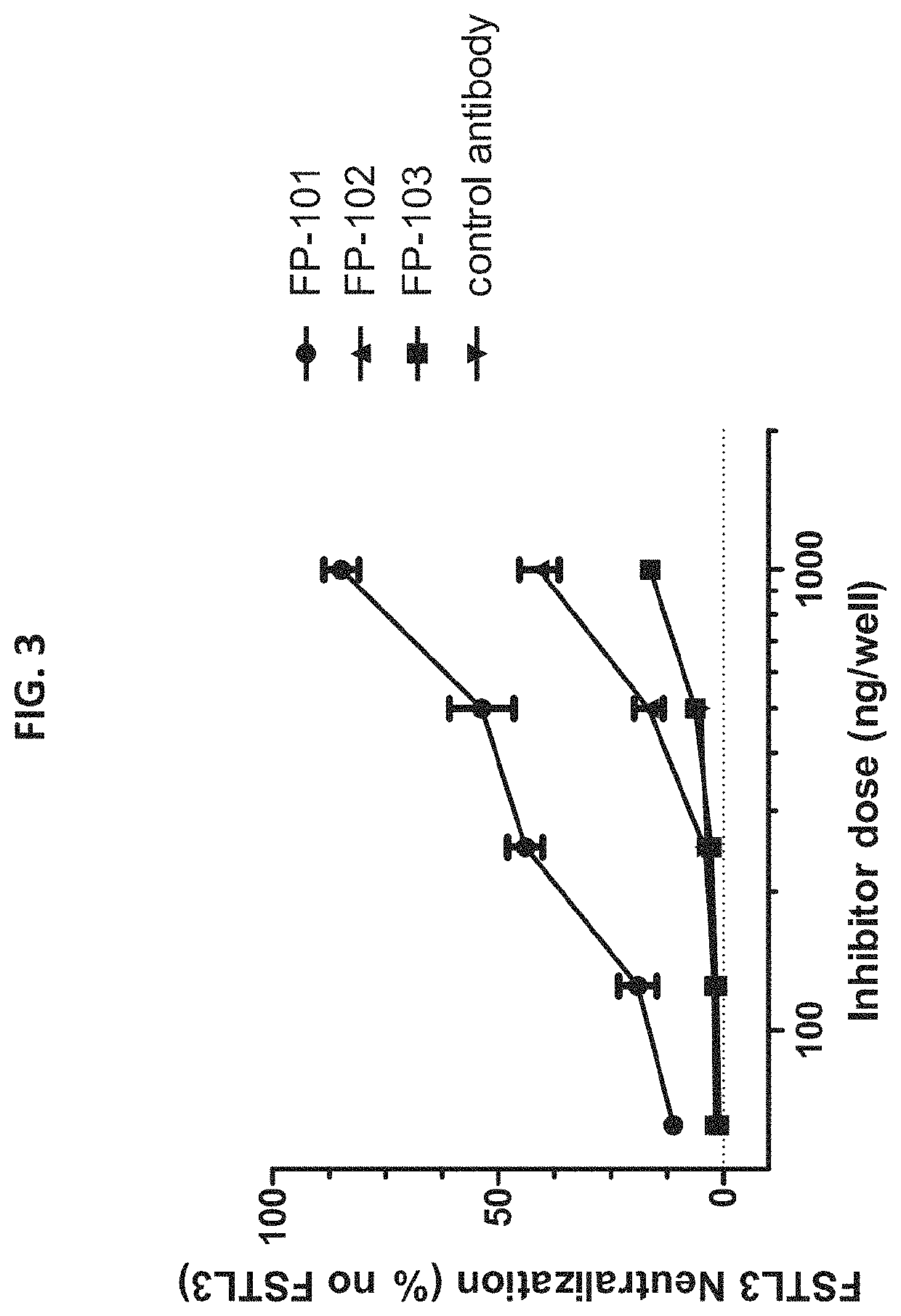Anti-follistatin-like 3 antibodies and treatment of diabetes
a technology of anti-follistatin and antibodies, applied in the field of diabetes treatment, can solve the problems of limited efficacy of available treatment options for diabetes, number of technical hurdles to be overcome, etc., and achieve the effects of minimal cross-reactivity, enhanced inhibition of fstl3 protein, and reduced side effects
- Summary
- Abstract
- Description
- Claims
- Application Information
AI Technical Summary
Benefits of technology
Problems solved by technology
Method used
Image
Examples
example 1
e Assay to Determine Optimal Amount of Human FSTL3 Required for the Neutralization of Activin A
[0113]Luciferase reporter assays were performed with a HEK293-(CAGA) cell line that stably expresses a (CAGA)-luciferase reporter gene, which was generated as previously described in Cash et. al., (J. Biol. Chem. 2012, 287, 1043-1053), which is incorporated by reference in its entirety. Cells were treated with varying amounts of activin A in serum-free medium for 24 h to determine the optimal dose of activin A required for the assay. Cells were washed with DPBS between removal of growth medium and addition of activin A in test medium which was DMEM with 0.1% BSA (Sigma, St Louis). FIG. 1A shows that increasing activin A dose causes an increase in luciferase biosynthesis, which is visualized as light when dual glow solution (Promega E2910) or similar commercial product is added. Background obtained from cells with no activin A treatment was less than 1000 relative light units (RLU). The opt...
example 2
of Monoclonal Antibodies and Antibody Characterization
A. Screening of Antibodies for Binding to Human FSTL3
[0114]Binding of antibodies to FSTL3 was determined by incubating 250 ng hFSTL3 / well in 100 μl of 0.1M Carbonate buffer pH 9 in immulon plastic 96 well plates overnight. The medium was aspirated and 200 μl of 3% BSA in phosphate buffered saline was added for 2 hours to block non-specific binding. This material was aspirated and 50 μl of conditioned medium containing anti-FSTL3 monoclonal antibodies (produced for Fairbanks Pharmaceuticals by Neo Scientific by standard monoclonal antibody methods in normal Balb-C mice) was added for 2-4 hours. Unbound protein was removed by washing three times for 5 min with 200 μl wash buffer (0.01% Tween in 10 mm PBS solution). 100 μl of secondary antibody (Goat-anti-Mouse IgG-Alkaline Phosphatase) was then placed in the wells. At the end of this step, the wells are washed again and a substrate for the enzyme was added, resulting in the product...
example 3
ation Activity of Anti-hFSTL3 Antibodies on Human FSTL3 Bound to TGFβ-Family Ligands
A. Neutralization of TGFβ-Family Ligands by Human FSTL3
[0116]A luciferase assay was performed as described above in Example 1. Varying amounts of human FSTL3 were mixed with varying pre-determined amounts of activin A, activin B, GDF11 or myostatin ligands (that produce approximately 100,000 RLU) in 96-well plates containing 293-Caga Luc cells. Luminescence measurements were taken as described earlier and the results were plotted (FIG. 4). FIG. 4 shows that the amount of human FSTL3 required to neutralize varied widely among the different ligands tested. The smallest amount of FSTL3 was required to neutralize activin A (solid circle) compared to the other ligands (see FIG. 4, the curve with the solid circle is shifted to left relative to the other curves). GDF11 (solid inverted triangle) and activin B (solid triangle) are neutralized by increasing amounts of FSTL3 in the order referenced herein. MSTN...
PUM
| Property | Measurement | Unit |
|---|---|---|
| size | aaaaa | aaaaa |
| concentration | aaaaa | aaaaa |
| affinity | aaaaa | aaaaa |
Abstract
Description
Claims
Application Information
 Login to View More
Login to View More - R&D
- Intellectual Property
- Life Sciences
- Materials
- Tech Scout
- Unparalleled Data Quality
- Higher Quality Content
- 60% Fewer Hallucinations
Browse by: Latest US Patents, China's latest patents, Technical Efficacy Thesaurus, Application Domain, Technology Topic, Popular Technical Reports.
© 2025 PatSnap. All rights reserved.Legal|Privacy policy|Modern Slavery Act Transparency Statement|Sitemap|About US| Contact US: help@patsnap.com



